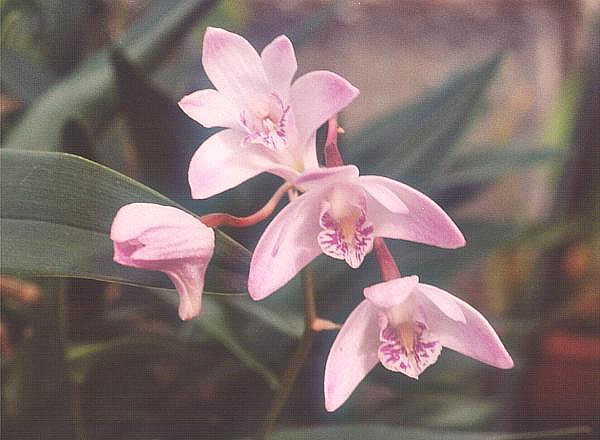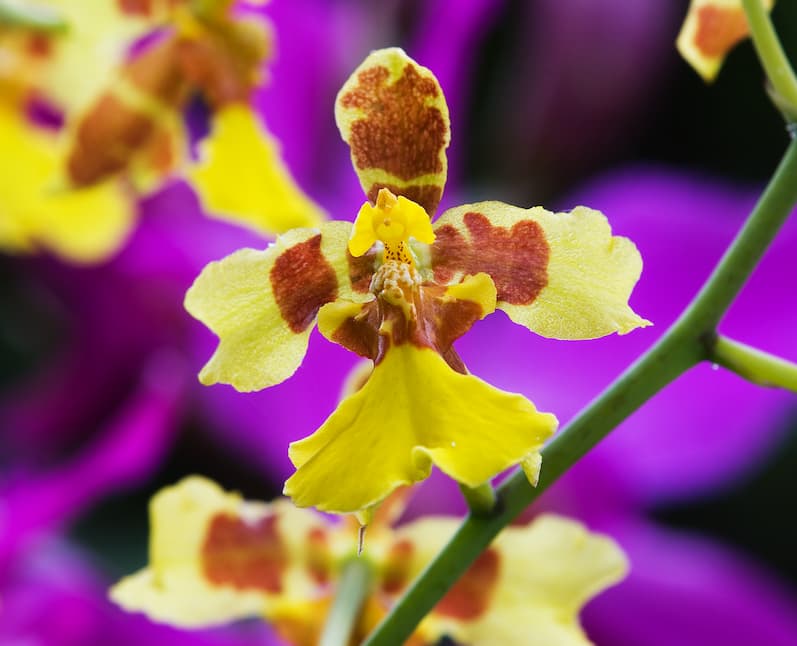Orchid Care Is About Recreating Habitats
Basic orchid care attempts to recreate the habitat in which a certain variety of orchid developed. Some bloom November-December and others May-June – although hybrids may bloom just about any time. In nature many are epiphytes growing on a branch. When it rains plant detritus/insect debris washes over the roots which have evolved to get their food from this.
Types of Orchids
From the American Orchid Society, five common types of orchids:
- Phalaenopsis (moth orchid, perhaps easiest to grow);

Credit: Uoaei1, CC BY-SA 4.0 https://creativecommons.org/licenses/by-sa/4.0, via Wikimedia Commons
- Dendrobium (similar care; quite a few bloom in winter, but deciduous and leaves fall);

Credit www.larsen-twins.dk, via Wikimedia Commons
- Oncidium (slower growing, commonly called “dancing lady” as blossoms seem to have arms and a ruffled skirt);

- Cymbidium (plants look like a clump of grass; temperature critical as a light frost needed to set flowers – think of Showy Lady’s Slipper)

Credit JLPC via Wikimedia Cmmons
- Cattleya (corsage orchid).

Credit:Sapporo, Hokkaido, Japan, CC BY 2.0 https://creativecommons.org/licenses/by/2.0, via Wikimedia Commons
Fertilizing Orchids
It is recommended to give orchids a small amount of fertiliser every time they are watered, at one-quarter the required intensity. “Weekly, fertilize weakly!” Potassium may aid in the formation of an inflorescence (the spike from which blooms emerge) and subsequent flowering.
Orchids and Water
Of course, effective orchid care requires adequate watering. In their native habitat, water naturally flows away from orchids. Spraying the bark and roots is an option. Plants placed on top of stones in a tray of water can help to improve humidity. Except for the Showy Lady’s Slipper, which thrives in bogs, orchids should never be submerged in water since most have not evolved to sit in the damp.
Orchids and Light
Orchids want bright light, therefore placing them near east or southeast facing windows with sheers is ideal. When exposed to too much light, orchid leaves begin to yellow. To simulate their natual environment, consider raising or lowering light intensity (moving the plant away from the light) and laying off on watering (one month);
Most orchids grow in tropical climates where days can range from humid with a high of 30°C to 10-15° overnight, so it is also beneficial to give a 15°C temperature variation.
Here are orchids that do well in shade gardens.
Repoting Orchids
If an orchid is trying to escape its pot, it’s a sign that it needs repotting! Your orchid is talking to you. In repotting, the goal is to replace degraded medium with fresh material and not to move up a pot size.
For best orchid care when repotting, cleanliness must be a priority because diseases such as mosaic virus and the possibility of the transfer of bugs. To sterilize his scissors and small knife he held them over a small burner. As he made cuts, Doug sprinkled cinnamon spice; it is a natural disinfectant besides making things smell nice. He also had a sprayer with a mix of nine parts water, one part rubbing alcohol and squirt of oil-based soap, e.g. Murphy’s oil. Alcohol will dry out bugs and oil-based soap is neurotoxic to bugs. Orchid plants need an inflorescence stalk to bloom, thus you do not want to cut it off. Doug might trim to just above the node where the spike has flowered; however, if the stalk continues to dry and is not viable he cuts it off.
When repotting, cleanliness must be prioritised due to illnesses such as mosaic virus and the danger of pest transmission.
- Hold trimming scissors or a small knife over a small flame to disinfect them.
- Sprinkle cinnamon spice, a natural disinfectant, on your cuts.
- Use a sprayer filled with nine parts water, one part rubbing alcohol, and a drop of oil-based soap, such as Murphy’s oil. Bugs will be dried out by alcohol, and oil-based soap is neurotoxic to them.
- Because orchid plants require an inflorescence stalk to blossom, you should not chop it off.
- Trim the spike to just above the node where it has bloomed; but, if the stalk continues to dry and is no longer viable, cut it off.
Use of Plastic Pots
Plastic pots with many holes will drain better than pots with few holes. If using a beautiful jardinière, place pebbles to raise the pot; orchids should not be resting in water, since this might cause root rot. Coconut fibres with a sphagnum moss covering appear to work best as a planting medium. It is natural, retains water, permits air passage, and is available in a variety of sizes. Sort out finer bits of your pot for plants with delicate roots. Clean your pot before using it. Plastic pots typically have a three-year lifespan before degrading to the point of replacement. Consider soaking the coconut fibres because a moist medium does not desiccate orchid roots.
If orchids are to be set outside in the summer, place an old copper penny in his pots to ward off slugs. (A small piece of copper wire would work as well.)
Propagation
Although some orchids are still propagated from seeds, this is a difficult task best left to experts. The majority of commercial orchids are developed from cultured meristems. Because phalaenopsis orchids are typically cheaper than cut flowers, some customers just discard them once they bloom. Phalaenopsis cannot be separated like clump-forming orchids since it has a single stem.
Identifying a mature vertical stem that has grown to an acceptable length and splitting to create new plants is the process of stem propagation. The old, original plant is then often discarded.
Plantlets with their own roots on the blooming stem can be cut off and planted in species and cultivars that generate them.
Growing and Caring for a Vanilla Plant
Diod you know the Vanilla Plant was a type of Orchid? We have an article dedicated to growing Vanilla Plants.
For more information on orchids, here are some of the orchids growing at the Vallarta Botanical Garden
Presenter
The Ottawa Orchid Society’s Douglas Vye gave a presentation on basic orchid care at the Old Ottawa South Garden Club. Doug has been cultivating orchids for over 20 years, and his main focus has been on what to do after the blossoms have dropped in order to encourage fresh blooms.







Leave a Reply
You must be logged in to post a comment.